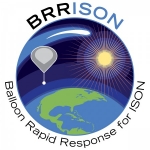Displaying items by tag: BRRISON
Balloon Rapid Response for ISON (BRRISON)
The BRRISON mission is an unprecedented rapid response to the opportunity presented by the discovery of comet ISON, providing a new planetary science platform which will fly above 99.5 percent of the atmosphere within one year of this discovery. It is the first NASA Planetary Science Division balloon mission to observe a comet.
The Comet ISON was discovered in September 2012, and is of great interest to scientists as it may hold clues to the formation of the solar system. The comet is believed to be making its first ever visit to the inner solar system.
Before the comet's close approach to the Sun in late November 2013, NASA will launch a special stratospheric balloon – the Balloon Rapid Response for ISON (BRRISON) – carrying a 0.8 m telescope and optical and infrared sensors to study the comet from above nearly all of Earth's atmosphere. The atmosphere is opaque at the light wavelengths that scientists want BRRISON to measure, which means those measurements are not possible from the ground. BRRISON will observe Comet ISON in the near-infrared and in the near-ultraviolet and visible wavelength ranges at an altitude of 120,000 feet. The near infrared camera will measure the ratio of carbon dioxide (CO2) to water (H2O) emissions from the cometary nuclei as a vital diagnostic of the comet's origins. These are unique observations that cannot be obtained by any other means. The near ultraviolet and visible camera will observe at the wavelength of the hydroxyl (OH) emission from Comet ISON and will test and characterize the effects of atmospheric turbulence on optical observations at balloon altitudes.


